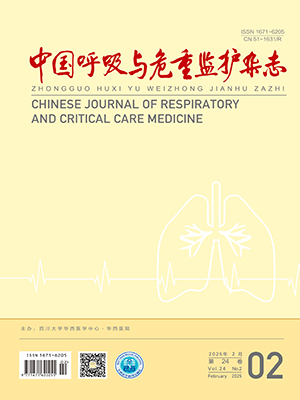| 1. |
Global Initiative for Chronic Obstructive Lung Disease (GOLD): Global strategy for the diagnosis, management and prevention of chronic obstructive pulmonary disease. (2017 REPORT). http://goldcopd.org.
|
| 2. |
慢性阻塞性肺疾病急性加重(AECOPD) 诊治专家组. 慢性阻塞性肺疾病急性加重 (AECOPD) 诊治中国专家共识 (2017 年更新版). 国际呼吸杂志, 2017, 37(14): 1041-1057.
|
| 3. |
Celli BR, Owen CA. The club cell and its protein, CC16: time to shine. Lancet Respir Med, 2013, 1(10): 757-759.
|
| 4. |
McAuley DF, Matthay MA. Clara cell protein CC16: a new lung epithelial biomarker for acute lung injury. Chest, 2009, 135(6): 1408-1410.
|
| 5. |
Broeckaert F, Bernard A. Clara cell secretory protein (CC16): characteristics and perspectives as lung peripheral biomarker. Clin Exp Allergy, 2000, 30(4): 469-475.
|
| 6. |
Laucho-Contreras ME, Polverino F, Gupta K, et al. Protective role for club cell secretory protein-16 (CC16) in the development of COPD. Eur Respir, 2015, 45(6): 1544-1556.
|
| 7. |
Long XB, Hu S, Wang N, et al. Clara cell 10-kDa protein gene transfection inhibits NF-kappaB activity in airway epithelial cells. PloS One, 2012, 7: e35960.
|
| 8. |
Lomas DA, Silverman EK, Edwards LD, et al. Evaluation of serum CC16 as a biomarker for COPD in the ECLIPSE cohort. Thorax, 2008, 63(12): 1058-1063.
|
| 9. |
Zhu L, Di PY, Wu R, et al. Repression of CC16 by cigarette smoke (CS) exposure. PloS One, 2015, 10(1): e0116159.
|
| 10. |
Petersen H, Leng S, Belinsky SA, et al. Low plasma CC16 levels in smokers are associated with a higher risk for chronic bronchitis. Eur Respir J, 2015, 46(5): 1501-1503.
|
| 11. |
Laucho-Contreras ME, Polverino F, Tesfaigzi Y, et al. Club cell protein 16 (CC16) augmentation: a potential disease-modifying approach for chronic obstructive pulmonary disease (COPD). Expert Opin Ther Targets, 2016, 20(7): 869-883.
|
| 12. |
Park HY, Churg A, Wright J, et al. Club cell protein 16 and disease progression in chronic obstructive pulmonary disease. Am J Respir Crit Care Med, 2013, 188(12): 1413-1419.
|
| 13. |
袁泉, 李斌, 陈果. 无创正压通气对 AECOPD 并发呼吸衰竭患者血清 KL-6、CC16 及和肽素水平的影响. 标记免疫分析与临床, 2017, 24(9): 1028-1032.
|
| 14. |
王文学, 吴飞燕, 黄文溪. 痰热清治疗慢性阻塞性肺疾病患者肺部感染疗效及对肺表面活性蛋白与克拉氏细胞蛋白的影响. 中华医院感染学杂志, 2015, 25(6): 1309-1311.
|
| 15. |
程艳慧, 张勇, 何东初. COPD 患者血清 IL-4、IL-8、TNF-α、CC16 水平变化与气道炎症损伤的探讨. 临床肺科杂志, 2010, 15(5): 661-663.
|




